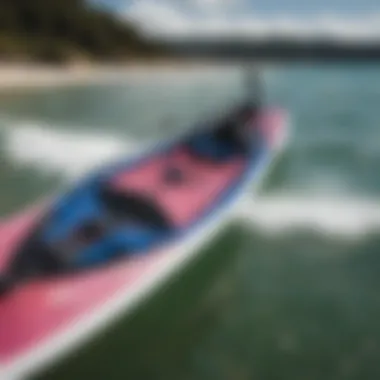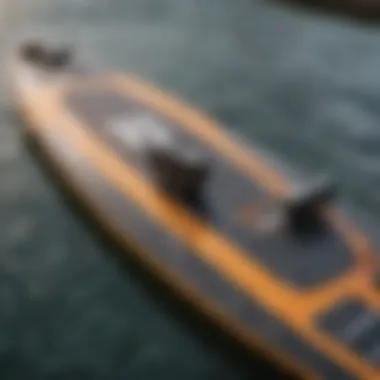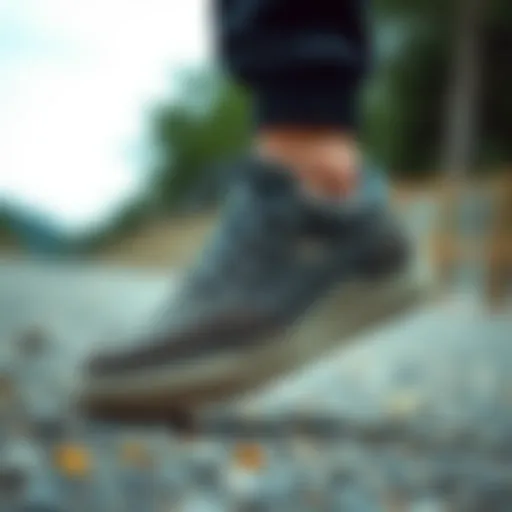In-Depth Review of the CrazyFly Kiteboard


Intro
Kiteboarding is not just a sport; it's a lifestyle—a thrilling escape that merges water and wind in a ballet of freedom and prowess. As enthusiasts of this mesmerizing activity know, the heart of kiteboarding lies heavily in the quality and design of your gear. Therefore, finding the right equipment can make or break your experience on the water. One brand that often comes up in discussions among kiteboarders is CrazyFly. Known for innovative designs and high-performance gear, CrazyFly has become a noteworthy contender in the kiteboarding scene.
This article dives into the nitty-gritty of the CrazyFly kiteboard, scrutinizing its construction, technological advancements, and overall performance. It caters to both novices looking to learn the ropes and seasoned riders seeking to refine their skills. Along with pinpointing key features, we’ll share personal accounts from users and compare CrazyFly with its competitors in the market. The goal? To paint a comprehensive picture that helps you make an informed decision on your kiteboarding gear.
Gear Essentials
Choosing the right equipment is paramount in getting the most out of your kiteboarding adventures. Here's an overview of crucial aspects to consider when selecting your essential watersports gear, specifically focusing on the CrazyFly kiteboard.
Top Picks for Watersports Equipment
When evaluating watersports gear, several fundamental attributes stand out, including durability, maneuverability, and adaptability. Here are a few top picks to consider:
- CrazyFly Kiteboard: With its robust construction and tailored designs aimed at optimizing performance, it quickly garners reputation.
- North Kiteboarding: This brand is synonymous with high quality and performance and often serves as a benchmark.
- Slingshot Sports: Known for reliability, Slingshot offers gear that can withstand intense maneuvers and adverse weather conditions.
Each of these brands brings something unique to the table, but CrazyFly stands out for its commitment to innovation and performance.
Maintenance and Care Tips for Gear
Speaking of longevity, how you care for your equipment directly impacts its performance. Here are some handy tips to keep your CrazyFly kiteboard and related gear in top shape:
- Rinse After Use: Always rinse your kiteboard with fresh water after each session. Saltwater can be corrosive and damage components.
- Check for Wear: Regularly inspect your board for signs of wear or damage, especially after a day of heavy use.
- Store Properly: Store your kiteboard in a shaded area or indoors to prevent fading and degradation caused by UV rays.
By adopting these simple yet effective practices, kiteboarders can ensure their gear lasts while maintaining peak performance.
Techniques and Tips
Now, getting the most out of your gear goes beyond merely possessing it; one must also enhance their skills and techniques.
Beginner Tips for Each Watersport
If you’re just starting out, kiteboarding can appear intimidating, but it doesn’t have to be. A few key tips can ease your way into this exhilarating sport:
- Start with a Lesson: Enroll in a beginner course to learn from professionals who can provide tailored guidance.
- Practice on Land: Get comfortable handling your kite on land before venturing into the water.
- Stay Hydrated: Always drink water before and after your sessions to remain energized.
Advanced Techniques for Skill Enhancement
For the more experienced kiteboarder looking to take their skills up a notch:
- Master Transitions: Work on your transitions to maintain momentum and flow in your movements.
- Try New Tricks: Push your boundaries by learning new jumps and tricks at a pace that feels natural to you.
- Engage with Community: Discussion forums and local kiteboarding clubs can provide a wealth of knowledge and support to refine your techniques further.
Remember, the journey of progression in kiteboarding doesn’t happen overnight. Patience and practice are your best friends.
By diving deep into techniques for both beginners and advanced users, this guide aims to enhance your kiteboarding experience with CrazyFly gear. The right equipment paired with informed skills can truly elevate your time on the water.
Foreword to CrazyFly Kiteboarding
Kiteboarding has steadily gained popularity over the years, and CrazyFly has carved out a notable presence in this vibrant niche. This section serves as an introduction, emphasizing the significance of CrazyFly kiteboarding. For enthusiasts and novices alike, understanding the offerings of CrazyFly provides insight into a brand that prioritizes innovation and performance.
Kiteboarding isn't merely a sport; it's an experience, a connection to the wind and water that few activities can match. CrazyFly stands at the crossroads of technology and playfulness, turning every ride into a statement of adventure. As we delve deeper, we'll explore the mechanics behind CrazyFly's designs, illustrating how these features not only enhance performance but also promote user engagement.
By engaging with the history and innovations of CrazyFly, readers will appreciate how the brand’s journey reflects broader trends in the kiteboarding realm. It’s not just about gliding over the water; it’s about harnessing the elements with style and efficiency.
Historical Background of CrazyFly
CrazyFly was initially founded in the late '90s, a time when kiteboarding was still in its infancy. Barely a few enthusiasts were exploring this exciting sport, making it the perfect breeding ground for those who dared to experiment and create. As the sport gained traction, CrazyFly grew, committed to a vision of high-performance gear that would soon win the hearts of many.
Over the years, CrazyFly developed a reputation for pushing boundaries. Their early kite models were fairly simple yet represented a robust effort to optimize performance. Fast forward to the present day, and their boards are a blend of cutting-edge materials and designs. They’re not simply products; they are an assembly of creative engineering, built to satisfy both the thrill-seeker and the casual rider.
With roots in the dynamics of water and wind, CrazyFly takes its heritage seriously, often reflecting on its journey as a testament to resilience and innovation in kiteboarding technology.
Kiteboarding Demystified
Kiteboarding can seem like a complex sport with its mix of gear and techniques, but it doesn't have to be daunting. At its core, kiteboarding hinges on a visceral understanding of balance, wind dynamics, and harnessing the power of the kite to glide across the water. CrazyFly has made efforts to break down these barriers, ensuring that both newcomers and veterans feel at home with their products.
What distinguishes kiteboarding from other water sports lies in its combination of freedom and skill. When kitesurfers take off, they literally elevate themselves above the waves. Harnessing the wind becomes a dance—a dynamic interplay between rider and nature. CrazyFly’s thoughtfully designed kiteboards contribute to this exhilarating experience by enhancing maneuverability and control.
To sum it up:


- Balance: The key to staying upright and enjoying your ride.
- Wind Dynamics: Understanding how to read the conditions is essential for safe and effective riding.
- Gear Matters: With CrazyFly, riders can trust that their boards are engineered for peak performance, no matter their skill level.
In exploring CrazyFly, kiteboarding’s layers become less mysterious, allowing ardent adventurers to fully immerse themselves in the thrilling world of kiteboarding.
Design Characteristics
When it comes to kiteboarding, the design characteristics of a board play a crucial role in its performance and suitability for different skill levels. In this section, we will unpack various elements that define the CrazyFly kiteboard and see how they contribute to its overall effectiveness on the water.
Construction Materials
Carbon Fiber
Carbon fiber has taken the kiteboarding world by storm, and for a good reason. This material is hailed for its exceptional strength-to-weight ratio. You get a board that is incredibly lightweight yet remarkably durable. This means that riders can maneuver with ease while enjoying high speed and stability.
One of the standout features of carbon fiber is its ability to absorb vibrations, which enhances the overall ride quality. It’s like having a smoother ride on a bumpy road. However, it’s worth mentioning that boards made from carbon fiber tend to come with a heftier price tag, so that's a consideration for budget-conscious riders.
Epoxy Resin
Epoxy resin is another key player in the construction of CrazyFly kiteboards. This material is known for its remarkable bonding strength and resistance to moisture. It creates a waterproof seal that is essential for a kiteboard that sees frequent exposure to the elements.
The high durability of epoxy resin reduces the risk of delamination, which is a common problem in boards subjected to high stress. That durability often results in longer-lasting performance. Still, while it provides excellent protection, some users feel that it can add a bit of weight compared to other materials, such as polyester.
Nylon Composite
Nylon composite boards might not be the first choice for competitive kiteboarders, but they are a solid option for many recreational users. This material is known for its flexibility, making it ideal for beginners who are learning to control their ride.
Nylon composite boards often come at a more affordable price, allowing entry-level kiteboarders to join the fun without breaking the bank. They can also have a decent lifespan, provided they are treated well. However, they may not offer the same level of performance and responsiveness as their carbon fiber or epoxy resin counterparts, particularly in high-speed scenarios.
Dimensions and Shape
The dimensions and shape of a kiteboard significantly influence both its performance and the riding experience. A deeper understanding of these attributes can help kiteboarders choose the right setup for their style and conditions.
Height
The height of a kiteboard can directly impact how it handles on the water. Taller boards tend to provide more floatation, which is beneficial for handling choppy waters or for those who enjoy jumping. A longer height might be perfect for intermediate to advanced riders looking to execute tricks or tackle larger waves.
However, while height contributes to performance, it can also affect stability. Riders accustomed to shorter boards might find taller boards a bit more challenging to control at first, especially during tight turns.
Width
With width being another key factor, a broader board usually results in increased stability and better upwind performance. For beginners, a wider board offers a more forgiving experience, making it easier to learn the ropes. A wider setup helps distribute weight, which can be particularly helpful in choppy conditions.
On the flip side, narrower boards provide more agility and can be beneficial for advanced riders who value quick turns and speed. Understanding the trade-offs here can guide you in selecting the right dimensions for your skill level and riding preferences.
Rocker Line
The rocker line, which refers to the curve from nose to tail, is an essential aspect of a kiteboard's design. A pronounced rocker creates a lift that allows for smoother landings and better maneuverability in waves. It can help riders catch air more easily, making it great for those who want to perform tricks.
However, too much rocker can compromise speed and efficiency when riding flat water. Riders need to find a balance that works for them—be it for performing acrobatics or just cruising along the coastline.
"The perfect kiteboard is not just about performance; it's also about understanding how various features come together to enhance your ride."
Performance Analysis
Performance Analysis is crucial in understanding how the CrazyFly kiteboard stands up to the rigors of diverse kiteboarding environments. It serves as a window into the capabilities of the board, revealing how it handles speed, stability, and jumps. For any kiteboarder, assessing these performance elements can dictate not just enjoyment but also safety during high-energy sessions. Important factors such as wind conditions, wave height, and user skill level must all be considered here. An informed choice based on solid performance data might just mean the difference between a thrilling ride and a troubled one.
Speed and Agility
When discussing speed and agility, it is pertinent to note that these are often the lifeblood of kiteboarding. The CrazyFly kiteboard boasts impressive glide and acceleration, which translates to fast turns and swift maneuvers. Riders engaging in speed-based competitions or freestyle tricks will find themselves gravitating towards boards that respond quickly and maintain high velocities without requiring excessive effort.
The unique design features, like the rocker line and outline shape, contribute significantly to this aspect. A flatter base allows for a more direct speed and quick transitions, whereas subtle curve adjustments aid in turns without losing pace. Riders often describe this experience as "like having your feet glued to a jet ski!" The board feels alive beneath them, able to flick and dart through the water. This agility can be particularly beneficial when dodging waves or navigating crowded beach spaces.
Stability in Varied Conditions
As any seasoned kiteboarder will tell you, stability can’t be overlooked, especially when conditions get tricky. The CrazyFly kiteboard was thoughtfully engineered to deliver a stable ride across a range of environments—from flat waters to choppy conditions. This aspect is vital, as instability can lead to difficulties in control, which can be downright dangerous.
One of the contributing factors to its stability is the width of the board. A wider board generally offers more surface area, helping to distribute the rider's weight more evenly. This is crucial when dealing with gusty winds or when hitting waves, as it helps to keep the board firmly planted on the water. Many riders have experienced less splash and smoother landings due to this stability aspect, turning potentially jarring experiences into seamless transitions through the air. A board that keeps its composure allows riders to focus on their technique and creativity, instead of battling the equipment.
Jumping Ability and Lift
Jumping ability is often the highlight of any kiteboarder’s experience. The CrazyFly kiteboard excels in this area, boasting a reputation for delivering ample lift and enabling smooth arcs during jumps. The dynamics of how the board interacts with the kite and the water make all the difference here. A board that generates high lift allows a rider to soar to new heights—literally.


When considering jumps, it is essential to also account for landing. The CrazyFly's design ensures a cushioned descent, thanks to its flex patterns and rail designs. Riders often report feeling as though they are landing on a cloud, thanks to the board's ability to absorb impact. This aspect not only boosts confidence in performing tricks but also hints at lesser chances for injuries, which is a significant concern among experienced riders.
"The thrill of soaring high can be exhilarating, and with the CrazyFly beneath your feet, it transforms hope into reality through seamless lift and landing."
Overall, while choosing a kiteboard, performance analysis can provide a clear sense of what works well for individual needs. The CrazyFly kiteboard showcases characteristics that cater to both speed enthusiasts and those who enjoy more technical maneuvers. Understanding these performance insights can help kiteboarders make more informed choices, ensuring their gear is well-suited for their next adventure.
Skill Levels and User Recommendations
Understanding the different skill levels in kiteboarding is essential for anyone looking to choose the right equipment, particularly the CrazyFly kiteboard. Each rider starts somewhere along their journey, and the kiteboard one selects can greatly influence progress and enjoyment. This section aims to break down the various skill levels and the specific features or benefits each category should consider.
Beginner-Friendly Options
For newcomers to kiteboarding, the right equipment can make all the difference. CrazyFly offers a range of options tailored specifically for beginners. Here are some of the aspects that make certain boards more suitable for less experienced riders:
- Stability: Boards designed for beginners often feature a wider and flatter shape. This design lends itself to better stability, enabling new kiteboarders to find their balance more easily on the water. A stable board reduces the chance of wipeouts, thus boosting confidence.
- User-Friendly Size: Beginners should opt for boards that are larger in size. A larger kiteboard provides better flotation, making it easier to get up and ride. The CrazyFly boards available for novices often come in larger dimensions, ensuring easier starts and smoother rides.
- Soft Flex: A board with softer flex can assist in reducing jarring impacts caused by choppy water, making for a more forgiving ride. This is particularly beneficial for beginners still mastering their control.
- Easy to Control: Many entry-level boards offer user-friendly setups, including options designed for easy launching and landing. CrazyFly’s boards often come with enhanced grip features, making it simpler for beginners to manage their feet and their stance.
"Choosing a kiteboard as a beginner is like picking the right pair of shoes; comfort is key for the journey ahead."
Intermediate and Advanced Features
Once riders have gained confidence and honed their skills, they may wish to explore CrazyFly’s intermediate and advanced offerings. These boards often come packed with features aimed at enhancing performance and pushing boundaries. Here’s what to expect:
- Enhanced Performance: Advanced riders often seek boards that offer faster speeds and sharper turns. CrazyFly boards for this skill level frequently incorporate design features that enhance performance, including steeper rocker lines and more responsive edges.
- Personalization Options: Many CrazyFly boards available for intermediate and advanced users offer customization options. Riders can select specific setups that suit their riding styles—whether they prefer freestyle, freeride, or wave riding.
- Durability: Experienced kiteboarders often take their gear through more rigorous use. CrazyFly has engineered their advanced boards with advanced materials, which add durability without sacrificing performance. This is particularly beneficial for riders who push the limits of their equipment.
- Higher Lift and More Control: Boards targeted at skilled riders typically come with features that allow increased lift during jumps, while maintaining control even in challenging conditions. This could include adjustable fins and specialized shapes conducive to carving out turns.
For those kitesurfers and paddleboarders looking to elevate their skills, switching to a more advanced CrazyFly kiteboard is a step towards serious progress. Whether you're just starting or well on your way to mastering the sport, selecting the right board can be pivotal.
Comparative Analysis
In the world of kiteboarding, the variety of brands and models can sometimes boggle the mind. Conducting a comparative analysis is crucial for any serious rider. By understanding how CrazyFly stands against its competitors, you can better assess your options, ensuring you get a kiteboard that matches your riding style and conditions. An effective comparative analysis provides insight into performance metrics like speed, stability, and responsiveness, which can make all the difference between a great day on the water and a mediocre one. Moreover, it helps users identify which features are essential based on their skill level and preferred riding discipline, essentially saving time and money in the long run.
CrazyFly vs. Other Brands
When it comes to kiteboarding gear, several major brands can stake a claim to leadership positions, each offering unique characteristics that set them apart. The comparisons below highlight how CrazyFly measures up to the competition, particularly against North Kiteboarding, Naish, and Slingshot.
North Kiteboarding
North Kiteboarding is a brand that's garnered a loyal following, thanks in part to its commitment to cutting-edge technology and dependable performance. Known for their superior build quality, North boards excel in handling variable conditions, a characteristic that many riders deem essential. What sets North apart is their use of advanced materials, ensuring both lightweight construction and durability. The NX series, for example, is admired for its excellent pop and smooth landings, attracting freestyle enthusiasts.
However, some riders find the North boards on the pricier side, which might be a deterrent for beginners who are still testing the waters. Additionally, while the boards are designed for agility, they may take some time to get accustomed to for new users. Still, those aiming to improve their tricks and maneuverability may find North Kiteboarding a worthy investment in their gear collection.
Naish
Naish is often considered synonymous with innovation in kiteboarding. Their products are especially popular in wave riding due to the brand's specialized designs that offer exceptional control and responsiveness in choppy waters. The Naish Pivot, for instance, is a standout model that many wave riders praise for its versatility and stability.
The brand's strength lies in its tailored approach—each product is purpose-built for specific riding styles, making it a go-to choice for serious disciplines. Despite its advantages, Naish boards generally fall on the higher end of the price spectrum, which can be off-putting for beginners. Some experienced users also report that the boards may feel less forgiving than others, particularly in harsh conditions. Nevertheless, Naish boards can elevate the riding experience for those who appreciate their specialized features.
Slingshot
Slingshot has marked its territory with a focus on user-friendly designs that cater to a wide range of skill levels. The brand’s distinctive feature is its commitment to providing an inclusive experience—not just for seasoned pros, but also for newcomers. The Slingshot尤物 series, known for its adaptability, encourages riders to try various styles without feeling overwhelmed by technical complexities.
While Slingshot is praised for its accessibility, the trade-off can sometimes be a lack of advanced features that more experienced riders might crave. For competitive users, the performance aspects may not match those of brands like North or Naish. However, for those just starting or anyone looking for a fun and forgiving ride, Slingshot can be an excellent choice without breaking the bank.
Epilogue
The comparative analysis of CrazyFly with brands like North Kiteboarding, Naish, and Slingshot shows just how important it is to consider not only your experience level but also your riding ambitions. Each brand has its strengths and weaknesses, which can significantly influence your performance on the water. A well-informed choice not only enhances your skill development but also increases the joy you take from the sport, ensuring that every session is as exhilarating as the last.
User Experiences and Feedback
Understanding user experiences and feedback is crucial in the kiteboarding world. When it comes to products like the CrazyFly kiteboard, real-world testimonials shed light on how the board performs under various conditions and skill levels. Users provide insight into not just the highs of their experiences, but also the challenges encountered, which is invaluable for potential buyers.
One of the benefits of examining this feedback is that it helps identify trends. If multiple users highlight specific features positively or negatively, that information can guide future customers in their decision-making process. The particulars of user experiences align closely with their expectations, riding styles, and even local conditions, painting a rich tapestry of practical insights.
Testimonials from Kiteboarders
Hearing directly from kiteboarders who have used the CrazyFly kiteboard brings a fresh perspective. Many users rave about its performance, describing it as responsive and agile. For instance, a rider from Florida mentioned, "This board is like an extension of my body. I can feel every shift on the water; it’s satisfying." The focus here exemplifies how intuitive handling can greatly enhance the rider's connection to the sport.
On the other hand, some kiteboarders emphasize the learning curve they faced initially. A beginner from California expressed, "Getting used to the board took some time, but once I did, it really paid off. I can now keep up with the pros!" Such feedback showcases that while the CrazyFly may cater to experienced riders, it also offers a rewarding journey for newbies.
Moreover, testimonials can also bring to light issues that many may not consider. A rider shared a story regarding durability after an incident where their kiteboard sustained an unexpected scratch. They stated, "I was worried at first, but after a bit of repair, the board was back on the water looking good as new." This suggests that while the CrazyFly kiteboard is well-built, riders should still practice some preventative care.


Expert Reviews
Expert reviews of the CrazyFly kiteboard present a more technical and analytical approach to understanding its capabilities. Professionals in the kiteboarding industry often break down the kiteboard's specifications and assess performance metrics.
One seasoned instructor concluded, "The construction materials truly shine - the carbon fiber and epoxy provide a balance of strength and lightweight performance that few other boards can offer." Their observations highlight not just how a board functions, but what makes it stand out in the market contexts.
Experts also run comparative analyses against other brands, indicating where the CrazyFly excels or falls short. For example, an expert reviewer compared CrazyFly's durability to other models, stating, "While other brands may boast lighter options, the CrazyFly kiteboard offers a stability that can’t be matched in rougher waters. It gives peace of mind during big gusts."
Furthermore, professional assessments often involve comprehensive testing sessions where real-time feedback is gathered. A notable review from a kiteboarding magazine noted, "In wind gusts of over 25 knots, the CrazyFly remains steady and reliable, with a good lift that makes for thrilling jumps."
Maintenance and Care for Your Kiteboard
Taking care of your kiteboard is not just about keeping it looking good; it’s about prolonging its life and enhancing its performance. Regular maintenance ensures that your kiteboard performs at its peak, while also preventing unnecessary deterioration that could lead to costly repairs or replacements down the line. If you think ignoring maintenance is a good idea, think again. A well-maintained kiteboard can provide a smoother ride, better responsiveness, and increased safety on the water.
Cleaning and Storage Tips
Keeping your kiteboard in tip-top shape requires regular cleaning and proper storage. Here are some tips that can help you do just that:
- Rinsing After Use: After every kiteboarding session, rinse your board with freshwater to remove sand, salt, and other debris. This simple step prevents corrosion and buildup that could damage the board’s materials over time.
- Dry Thoroughly: Make sure to dry the board completely before storing it. Any residual moisture can lead to mold or mildew, which is never a pleasant discovery when you pull it out for your next session.
- Proper Storage Location: Store your kiteboard in a cool, dry place. Avoid attics or damp basements, as fluctuating temperatures can warp or damage your board. Ideally, keep it in a protective bag to shield it from dust and potential scratches.
- Avoid Direct Sunlight: UV rays can weaken the materials used in your kiteboard over time. If you can, keep it out of direct sunlight when not in use.
- Inspect Markings and Accessories: Check for any scuffs or scratches on the board after each session. Noticing small cosmetic issues can help catch larger problems early on.
Using these storage and cleaning tips will not only maintain the aesthetics of your kiteboard but also improve its lifespan.
"A stitch in time saves nine," and this is particularly true when it comes to caring for sports equipment.
Repairing Common Damages
No board is immune from wear and tear. Kiteboards can suffer from scratches, dents, or even delamination due to frequent use or accidental bumps. Addressing these damages promptly is crucial. Here’s how you can tackle some common repairs:
- Scratches: Light scratches can often be polished out using a soft cloth and some mild abrasive cleaner. For deeper scratches, consider using a resin filler or contacting a professional.
- Dents: Small dents might pop out with some gentle heat from a hairdryer, followed by immediate cup rule pressure. Or for more severe dents, a professional repair shop should be consulted.
- Delamination: This is a more serious issue that generally requires professional intervention. If you notice the layers of the board separating, it’s best to seek help immediately.
- Repairs Kits: Invest in a quality repair kit designed for kiteboards. This will keep you prepared for minor fixes on the spot.
Future Innovations in Kiteboarding Technology
As we continue to explore the vast waters of kiteboarding, the role of technology becomes ever more pronounced. Innovations in kiteboarding technology not only enhance performance but also create a more enjoyable experience for riders at any level. It's not just about having the flashiest gear; it’s about how the advancements can directly impact safety, usability, and thrill. This section delves into emerging material trends and smart equipment, outlining the future landscape of this exhilarating sport.
Emerging Trends in Materials
The conversation around materials in kiteboarding is heating up. Traditionally, kiteboards were made from a limited selection of materials, but the future is decidedly more diverse. One key trend is the rise of lighter and stronger materials. For instance, the use of carbon fiber has become a game-changer. This material offers an impressive strength-to-weight ratio that makes boards easier to maneuver without compromising durability. Riders will find themselves gliding through the water with less effort, leading to longer sessions on the waves.
Another exciting development is the incorporation of bio-composite materials. These are made from natural fibers and are designed to reduce the environmental impact of kiteboarding. With an increased awareness of sustainability in the sports industry, materials like flax and hemp are being integrated into board design. This not only lightens the board but also contributes positively to the planet, showing that kiteboarding can progress while respecting nature.
Moreover, advances in epoxy resin technology have allowed for the creation of more flexible yet durable boards. This flexibility can enhance the rider's ability to perform tricks and improve comfort during those rough rides.
Smart Kiteboarding Equipment
The concept of smart technology is making its way into the kiteboarding scene, providing gear that connects with riders like never before. Picture this: kiteboards equipped with sensors that give real-time data on conditions such as wind speed, the rider's performance, and even health metrics. This data can be crucial for both training and safety, helping users make immediate adjustments based on the environment.
For example, a smart control system could alert the rider when they are nearing their limits, suggesting a decrease in speed or a change in course. This could seriously cut down accidents and injuries that often occur due to overexertion or misjudgment.
Moreover, companies are starting to explore wearable technology that tracks the rider’s movement and jumps. This allows athletes to analyze their tricks and refine their skills. Not only does it make for a more engaging experience, but it can also enhance performance by providing actionable feedback.
"The future of kiteboarding lies at the intersection of innovation and sustainability. With the right mix of smart technology and eco-friendly materials, the sport can continue to thrive while minimizing its impact on the environment."
Ending and Final Thoughts
In this article, we've journeyed through the layers of the CrazyFly kiteboard, unearthing its core features and analyzing its role in the kiteboarding landscape. The conclusion serves not just as an end point but also as a moment for reflection on the insights gained. Understanding the CrazyFly kiteboard means recognizing its blend of craftsmanship, technology, and the spirit of adventure it embodies.
The importance of this topic cannot be overstated. For surfers, paddleboarders, kitesurfers, instructors, and gear reviewers, the knowledge about the CrazyFly boards can influence equipment choices and ultimately enhance performance on the water. By parsing through the nuanced elements such as design characteristics, performance metrics, and user experiences, this comprehensive review offers an informed perspective that helps you make better decisions.
The benefits of grasping these details are vast:
- Informed Decisions: The comprehensive analysis equips riders with the insights needed to choose the right board for their skill level and style.
- Enhanced Performance: By understanding the technology behind the CrazyFly kiteboard, users can unlock their potential and improve their skill sets on the waves.
- Investment Value: Knowledge about the maintenance and care of these boards can extend their life, providing better long-term value.
As we wrap things up, let’s dive deep into the key points we discussed.
Summarizing Key Points
- Design and Construction: From the premium materials like carbon fiber and epoxy resin to the shape of the board, every aspect is engineered for optimal performance.
- Performance Metrics: CrazyFly kiteboards shine in speed, agility, stability, and lift, catering to various skill levels while offering a balanced ride.
- User Experiences: Real-world testimonials highlight the adaptability and resilience of these boards, painting a picture beyond mere specifications.
- Maintenance Practices: Simple cleaning and water specific storage tips contribute significantly to the longevity of the equipment.
- Future Outlook: Emerging technological trends indicate that CrazyFly is on the brink of innovative advancements that might reshape kiteboarding.
In summarizing, it's clear that each facet we examined builds the case for CrazyFly as a formidable player in kiteboarding. The information provided in this review arms you with knowledge that can make all the difference.
Future of CrazyFly in the Kiteboarding Market
As we gaze into the future of CrazyFly in the kiteboarding arena, several elements come into focus. First, the growing trend towards sustainability in materials and practices is likely to be a game-changer. CrazyFly has already shown a commitment to using eco-friendly resources, and extending this philosophy could further resonate with today's environmentally conscious consumers.
Additionally, the rise of smart kiteboarding equipment holds potential for CrazyFly's next innovations. Features like integrated tracking devices or performance monitors could not only elevate a rider’s game but also tap into a tech-savvy market. The advent of Virtual Reality training modules might also play a role, turning once niche experiences into mainstream training tools.
Another vital consideration is the global market's response. As kiteboarding continues to gain traction worldwide, how CrazyFly positions itself in emerging markets could dictate its trajectory. Local partnerships, tailored products based on regional climates, and community engagement could enrich its brand image.



